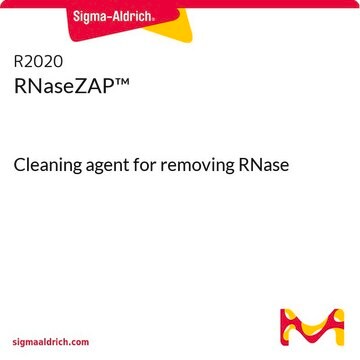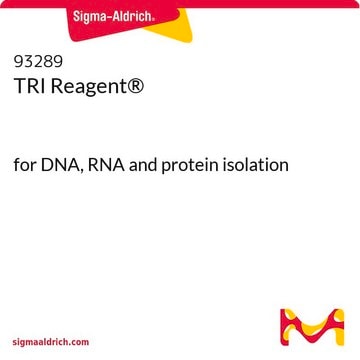This application may be possible. However, it has not been specifically tested.
R0901
RNAlater®
Stabilize and protect RNA with immediate RNase inactivation
Synonym(s):
RNA preservation solution, RNA protection solution, RNA protector, RNA stabilizer, RNA storage solution, RNA transportation solution
About This Item
Recommended Products
SMILES string
N([C@@H]([C@H](O)C)C(=O)N[C@@H](CCC(=O)O)C(=O)N[C@@H](CCCNC(=N)N)C(=O)O)C(=O)[C@@H](NC(=O)[C@@H](NC(=O)[C@@H](NC(=O)[C@@H](NC(=O)[C@@H](N)CCCNC(=N)N)CC(=O)N)C)CC(C)C)C
InChI
1S/C37H67N15O13/c1-16(2)14-23(50-28(57)17(3)46-33(62)24(15-25(39)54)51-30(59)20(38)8-6-12-44-36(40)41)32(61)47-18(4)29(58)52-27(19(5)53)34(63)48-21(10-11-26(55)56)31(60)49-22(35(64)65)9-7-13-45-37(42)43/h16-24,27,53H,6-15,38H2,1-5H3,(H2,39,54)(H,46,62)(H,
InChI key
DUCQRBNNHJNRMP-KDDVYCELSA-N
Related Categories
General description
RNAlater is an aqueous, non-toxic tissue storage reagent that rapidly permeates tissue to stabilize and protect cellular RNA in situ in unfrozen specimens. Tissue pieces are harvested and immediately submerged in RNAlater for storage without jeopardizing the quality or quantity of RNA. RNAlater eliminates the need to immediately process tissue specimens or to freeze samples in liquid nitrogen for later processing. RNAlater preserves RNA in tissues for up to 1 day at 37 °C, 1 week at 25 °C, and 1 month at 4 °C. Tissues can also be stored at -20 °C long-term.
RNAlater has been extensively tested on several tissues from vertebrate species, including brain, heart, kidney, spleen, liver, testis, skeletal muscle, fat, lung, and thymus. RNAlater is also effective for E. coli, Drosophila, tissue culture cells, white blood cells, and some plants.
Application
Features and Benefits
- No compromise in RNA quality following mRNA or total RNA isolation
- Rapidly permeates tissues to stabilize and protect cellular RNA
- Aqueous non-toxic solution allows downstream tissue processing
- Stabilizes samples at room temperature
Other Notes
Principle
Legal Information
also commonly purchased with this product
Storage Class Code
12 - Non Combustible Liquids
WGK
WGK 1
Flash Point(F)
Not applicable
Flash Point(C)
Not applicable
Choose from one of the most recent versions:
Already Own This Product?
Find documentation for the products that you have recently purchased in the Document Library.
Related Content
KOD One™ PCR Master Mix overview for ultra-fast PCR with high specificity, fidelity, and yield
KOD One™ PCR Master Mix overview for ultra-fast PCR with high specificity, fidelity, and yield
KOD One™ PCR Master Mix overview for ultra-fast PCR with high specificity, fidelity, and yield
KOD One™ PCR Master Mix overview for ultra-fast PCR with high specificity, fidelity, and yield
-
Hello, is it possible to submerge samples (1mm3) of myocardium to RNA later, and then the next week into liquid nitrogen? As -80°C freezers are not available? Will it affect RNA stability and its modifications?
1 answer-
Helpful?
-
-
What does RNAlater do to tissue like bone? Does it affect the mineral phase or not at all?
1 answer-
The effects of RNAlater on solid tissues, such as bone, has not been determined. However, this product has been used successfully on bone samples in several publications. Please see the links below to review these articles:
Maintaining mRNA Integrity during Decalcification of Mineralized Tissues
https://www.ncbi.nlm.nih.gov/pmc/articles/PMC3591421/An Improved Method for Isolating High-Quality RNA From Rat Bone at Room Temperature Without the Need for Specialized Equipment
https://www.ncbi.nlm.nih.gov/pmc/articles/PMC8027952/Improved method for isolating high-quality RNA from mouse bone with RNAlater at room temperature
https://www.sciencedirect.com/science/article/pii/S2352187219300178Helpful?
-
-
お世話になります。RNAlaterの購入を検討しています。いつも生体組織に対して使用することが多いのですが、今回はヘビの毒液に対して使用します。毒液のような液体に対しても使用可能でしょうか?また液体試料に特化したRNAlaterがありましたら、ご紹介いただけると幸いです。よろしくお願いいたします。
1 answer-
Unfortunately, this item has not been tested for use with venoms. However, a brief search of the literature reveals that the product has been used successfully in preserving saliva and plasma samples. Please see the link below to review one such publication. Ultimately, it would be up to the end user to determine suitability with venom.
https://pubmed.ncbi.nlm.nih.gov/12076286/Helpful?
-
-
Are there any references available on use of this product for measuring microbes in rock and soil samples?
1 answer-
The scientific literature offers information on isolating RNA from soil, with specific mention of RNALater. Relevant studies can be found in the PubMed Central database, including the articles with PMC reference numbers PMC4036013 and PMC2935057.
Helpful?
-
-
Can it preserve RNA in saliva?
1 answer-
RNAlater has been utilized with saliva samples and published in the academic literature. Please see the link below for an example.
https://journals.plos.org/plosone/article?id=10.1371/journal.pone.0229791
Helpful?
-
-
How long is the incubation time in the reagent before moving on to RNA extraction?
1 answer-
The recommended incubation period is specified as overnight at 2-8°C.
Please see the product data-sheet:
https://www.sigmaaldrich.com/deepweb/assets/sigmaaldrich/product/documents/110/789/r0901bul.pdfHelpful?
-
-
Is there a problem if I store it in the fridge? at 4°C
1 answer-
RNAlater has been validated for storage in room temperature. When in use, the product is stored with samples refrigerated, as well as frozen. Storing the product at 4°C should not pose a problem. Please see the link below to review the product datasheet:
https://www.sigmaaldrich.com/deepweb/assets/sigmaaldrich/product/documents/110/789/r0901bul.pdfHelpful?
-
-
If protein is extracted from RNA later treated tissues are posttranslational modifications (e.g. phosphorylation) influenced by the reagent?
1 answer-
The impact of RNAlater on post-translational modifications has not been investigated, however the article below may be helpful.
https://www.ncbi.nlm.nih.gov/pmc/articles/PMC5397022/Helpful?
-
-
Does RNAlater stop transcription upon addition or only preserves the RNA from degradation by RNAases?
1 answer-
RNAlater™ is used to stabilize and protect RNA with immediate RNase inactivation. It works by denaturing proteins, including RNase. The use of RNAlater™ RNA Stabilization Solution for tissue storage does not affect the outcome of subsequent RNA expression analysis experiments compared to other processing methods. It is worth noting that proteins will be preserved in RNAlater™ however, the solution will denature the proteins. Therefore, the protein obtained from samples stored in it will still be suitable for applications such as western blotting or 2D gel electrophoresis, but not for applications that require native protein.
Helpful?
-
-
What is the Department of Transportation shipping information for this product?
1 answer-
Transportation information can be found in Section 14 of the product's (M)SDS.To access the shipping information for this material, use the link on the product detail page for the product.
Helpful?
-
Active Filters
Our team of scientists has experience in all areas of research including Life Science, Material Science, Chemical Synthesis, Chromatography, Analytical and many others.
Contact Technical Service








